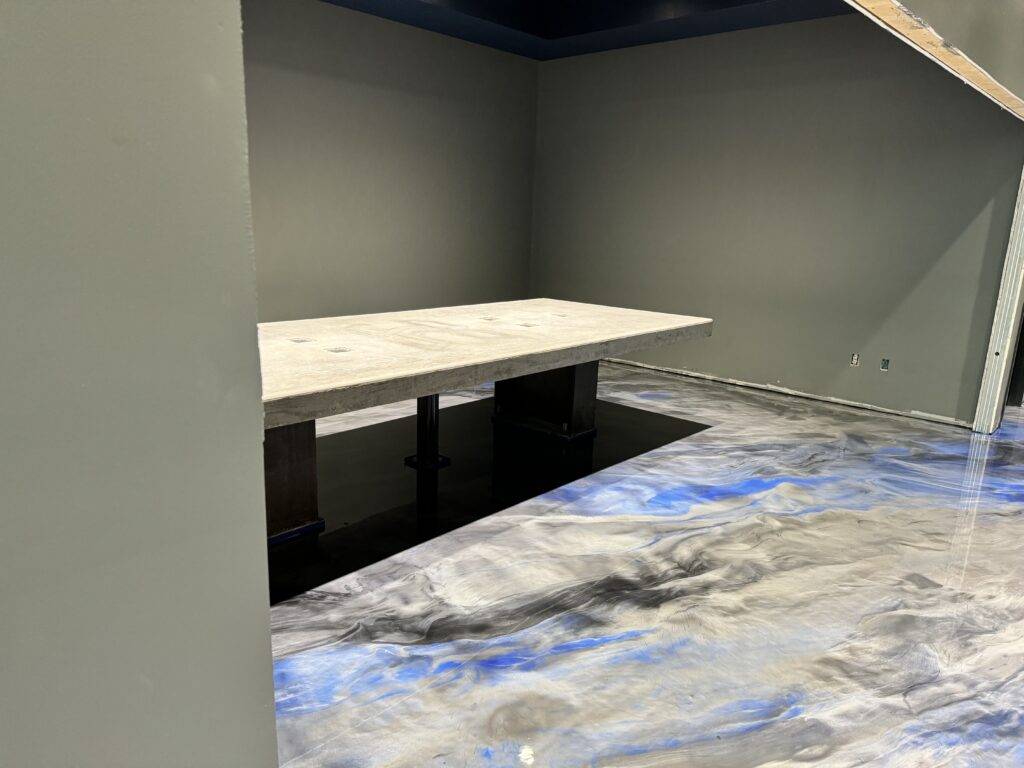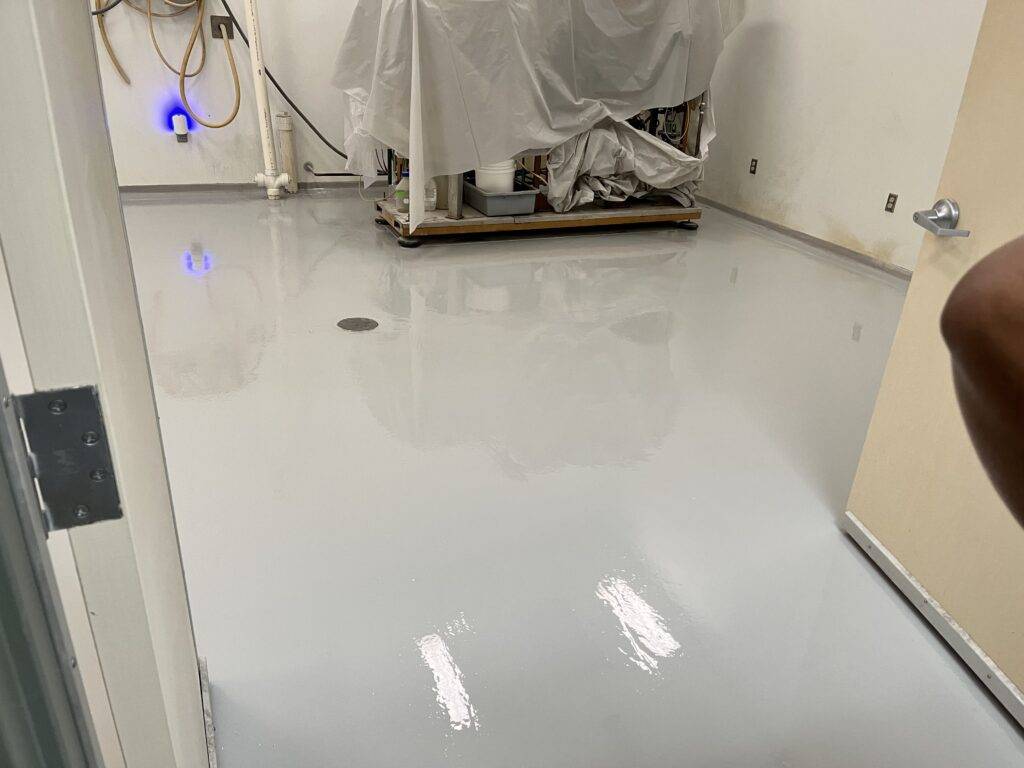Who We Help
Our expertise in polyaspartic coatings uniquely positions us to serve a wide array of clients, from homeowners looking to upgrade their living spaces to local businesses and industrial facilities in need of durable and long-lasting flooring solutions. For homeowners, polyaspartic coatings offer a transformative solution for garages, basements, patios, and more, providing a high-quality finish that is both aesthetically pleasing and resistant to the everyday wear and tear of residential life. The rapid cure time and UV resistance make it an ideal choice for both indoor and outdoor applications, ensuring a beautiful, maintenance-free surface that lasts for years and adds significant value to any home.
In the commercial and industrial sectors, the unparalleled durability and resistance of polyaspartic coatings stand up to the rigorous demands of high-traffic areas, heavy machinery, and harsh chemicals. Local businesses, including cafes, salons, and retail stores, benefit from the quick application process and the ability to customize finishes to align with their brand image, creating an inviting atmosphere for customers. For industrial clients, the robust nature of polyaspartic coatings ensures a safe, efficient, and long-term flooring solution capable of withstanding the harsh conditions of manufacturing plants and warehouses. Across all sectors, polyaspartic coatings deliver not just superior protection and longevity but also the flexibility and aesthetic appeal to meet the diverse needs of our clients.
Polyaspartic Coatings For Local Businesses
Polyaspartic flooring presents an ideal solution for local businesses seeking a blend of durability, rapid installation, and aesthetic versatility. Tailored to withstand the bustling environment of commercial spaces, this advanced flooring option ensures minimal downtime with its quick cure times, allowing businesses to resume operations almost immediately. The resilience of polyaspartic coatings against heavy foot traffic, spills, and abrasions makes it a smart investment for restaurants, retail stores, salons, and more. Its UV resistance ensures that the vibrant and customized finishes remain pristine over time, reflecting the unique brand identity of each business. Opting for polyaspartic flooring not only enhances the visual appeal of a space but also contributes to a safer, more inviting environment for customers and employees alike, setting a new standard in commercial flooring solutions.

Industrial Resin Floors
Industrial resin floors, particularly those utilizing cutting-edge polyaspartic technology, offer unparalleled benefits for demanding environments such as manufacturing plants, warehouses, and logistics centers. These floors are engineered to withstand extreme conditions, including heavy machinery, constant foot and vehicle traffic, and exposure to harsh chemicals and temperature fluctuations. The rapid curing properties of polyaspartic resin minimize downtime, a critical advantage in 24/7 industrial operations, allowing for a swift return to full productivity. Additionally, the superior durability and resistance of polyaspartic coatings ensure a long-lasting, maintenance-free surface that can endure the rigors of industrial use. By choosing polyaspartic resin floors, industrial facilities can achieve a balance of functionality, safety, and efficiency, enhancing workplace performance and long-term operational sustainability.
Polyaspartic Resin Coatings For Your Home
Polyaspartic resin coatings offer an innovative flooring solution for homeowners seeking to combine aesthetics with functionality in their living spaces. Ideal for garages, basements, patios, and more, these coatings provide a durable, resistant surface that can withstand daily activities, spills, and impacts, ensuring your floors remain pristine for years to come. The quick application and curing process of polyaspartic coatings means minimal disruption to your home life, with the added benefit of UV resistance to prevent fading or yellowing over time. Available in a variety of finishes and colors, polyaspartic resin allows you to customize your space to reflect your personal style, enhancing the beauty and value of your home while providing a practical, low-maintenance flooring solution.


Polyaspartic Coatings for Medical Practices
Polyaspartic coatings have emerged as a groundbreaking solution in the realm of medical practices, offering unparalleled benefits in terms of durability, hygiene, and safety. These advanced coatings are lauded for their rapid curing times, which significantly minimize downtime in fast-paced medical environments, allowing for swift resumption of operations. Their exceptional chemical resistance is particularly advantageous in medical settings, where the ability to withstand frequent and rigorous disinfection processes is paramount.
Polyaspartic coatings are also celebrated for their seamless and impermeable nature, which eliminates crevices that could harbor harmful microbes, thus enhancing the sterility of medical facilities. Furthermore, their robustness against abrasions and impacts ensures longevity, reducing the need for frequent maintenance. This combination of features makes polyaspartic coatings an ideal choice for medical practices striving to maintain the highest standards of cleanliness, safety, and operational efficiency.
Frequently Asked Questions
Polyaspartic and epoxy flooring have their strengths and are used for various purposes, depending on the specific environment’s needs.
Here’s a quick comparison between the two:
Durability: Both polyaspartic and epoxy are extremely durable and resistant to heavy traffic. However, polyaspartic is generally considered more flexible, making it more resistant to impacts and less likely to chip or crack.
Cure Time: Polyaspartic floors have a much faster cure time than epoxy. While an epoxy floor might take several days to cure, a polyaspartic floor can often be applied and fixed in a single day.
Temperature Sensitivity: Polyaspartic coatings can be applied at a broader range of temperatures than epoxy. This is especially beneficial for environments with significant temperature fluctuations.
UV Stability: Polyaspartic coatings are more resistant to yellowing from UV exposure, which can be a common problem with epoxy coatings over time.
Resistance: Polyaspartic is more resistant to chemicals, oil, and other substances that might stain or damage the floor. Epoxy is also resistant to these substances, but polyaspartic is generally considered superior.
Cost: Polyaspartic is typically more expensive than epoxy due to its superior performance and quick curing time.
Polyaspartic floor coatings distinguish themselves from epoxy coatings through a variety of advantageous properties, contributing to their extended lifespan. Here are several pivotal factors:
- Enhanced Durability: Boasting exceptional resistance to impacts, abrasions, and general wear, polyaspartic coatings outperform epoxy in durability, ensuring a longer lifespan for your flooring.
- Superior Chemical Resistance: With an elevated resistance to chemicals, polyaspartic coatings are less susceptible to damage from oil, gasoline, salts, and other aggressive substances that typically compromise epoxy coatings over time.
- Adaptability to Temperature Variations: Polyaspartic coatings maintain their integrity across a broader temperature spectrum, reducing the risk of cracking or peeling in extreme weather. Epoxy coatings, conversely, are prone to brittleness and cracking in severe cold or heat.
- UV Stability: Unlike epoxy, which can yellow and dull when exposed to sunlight, polyaspartic coatings are resistant to UV radiation, preserving their color and sheen over time.
- Quicker Curing Process: The ability of polyaspartic coatings to cure rapidly, within a matter of hours, minimizes the risk of contamination during the curing phase, leading to a more robust and enduring finish.
While polyaspartic coatings offer these significant advantages, it’s important to consider that they may come with a higher price tag and require more precision during application than epoxy coatings. Furthermore, the durability and lifespan of any floor coating, whether polyaspartic or epoxy, greatly depend on thorough surface preparation, meticulous application techniques, and consistent maintenance practices.
Epoxy flooring is renowned for its ability to achieve a high-gloss finish, thereby enhancing the reflectivity of the floor surface. It offers a virtually limitless array of colors and designs, from decorative flakes and aggregates to striking metallic or marble effects. Additionally, epoxy flooring can be customized with unique designs and logos, making it an attractive choice for commercial or public spaces. Despite these benefits, one drawback of epoxy is its susceptibility to yellowing or fading when exposed to UV light, which can detract from its aesthetic appeal over time.
In comparison, polyaspartic flooring boasts a similarly broad selection of colors and styles, with the added advantage of UV resistance, preventing yellowing or fading under sunlight. This type of flooring also offers a uniform gloss finish, potentially offering greater visual appeal in certain environments. Furthermore, polyaspartic floors are notably resistant to scratches and general wear, contributing to their long-lasting appearance.
Choosing between polyaspartic and epoxy flooring involves more than just aesthetic considerations; factors such as the floor’s intended purpose, budget constraints, the feasible downtime for installation, and anticipated maintenance requirements also play crucial roles in the decision-making process.
Polyaspartic floor coatings stand out for their rapid curing rates relative to other flooring solutions, like epoxy or urethane-based coatings. The exact curing duration can fluctuate based on the specific formulation used, environmental conditions at the time of application, including temperature and humidity, as well as the application’s thickness.
Typically, a polyaspartic coating is set to handle light foot traffic within a mere 2 to 4 hours following its application, achieving full cure status in about 24 hours.
Polyaspartic flooring boasts exceptional durability and resistance, making it an ideal choice for both high-traffic commercial and industrial environments, as well as residential garages. Its resilience and easy maintenance are key benefits. Here’s a comprehensive guide on how to keep your polyaspartic floors clean and in prime condition:
Sweeping or Vacuuming:
- Regularly sweeping or vacuuming is crucial to remove dust, dirt, and debris. This step helps in preventing the accumulation of grime and maintains the aesthetic appeal of your flooring. Opt for a soft-bristled broom or a vacuum cleaner without a beater bar to avoid scratching the floor’s surface.
Mopping:
- Follow up the sweeping or vacuuming with mopping for a more thorough cleaning. Utilize a microfiber mop along with a gentle, pH-neutral floor cleaner to avoid potentially damaging the coating. Steer clear of harsh chemicals that could deteriorate the floor’s finish over time.
Spot Cleaning:
- For specific areas that need extra attention due to stubborn stains or spills, spot cleaning is effective. Promptly addressing spills will prevent them from becoming permanent. Use a suitable degreaser for oil or grease marks, adhering to the manufacturer’s recommendations for any cleaning product you apply.
Drying the Floor:
- After mopping or dealing with spills, make sure the floor is completely dry to eliminate any risk of slipping. You can either use a dry mop, towels, or simply let the floor air dry, depending on your preference and the specific situation.
Periodic Deep Cleaning:
- The frequency of deep cleaning depends on the level of foot traffic your flooring endures. For a deep clean, employ a floor scrubber equipped with a soft brush attachment paired with a mild cleaning solution. After scrubbing, it’s important to rinse the floor with clean water and then dry it thoroughly to ensure no residue is left behind.
Adhering to this cleaning regimen will help maintain the integrity and appearance of your polyaspartic flooring, ensuring it continues to perform well and look great for years to come.










